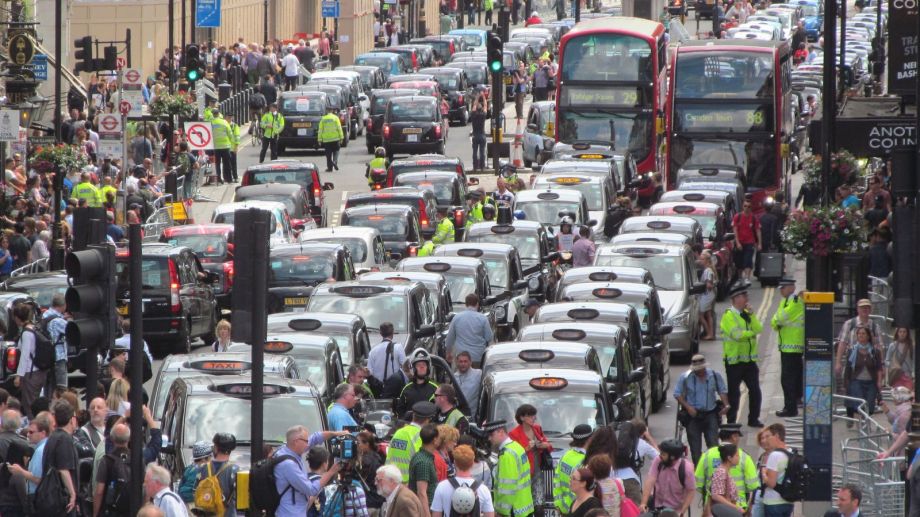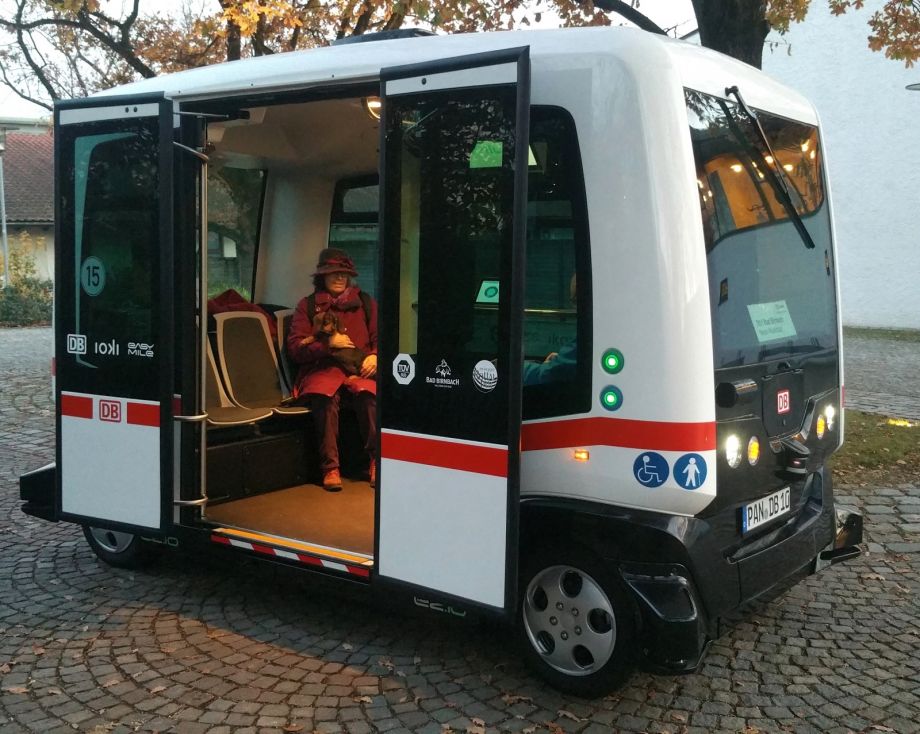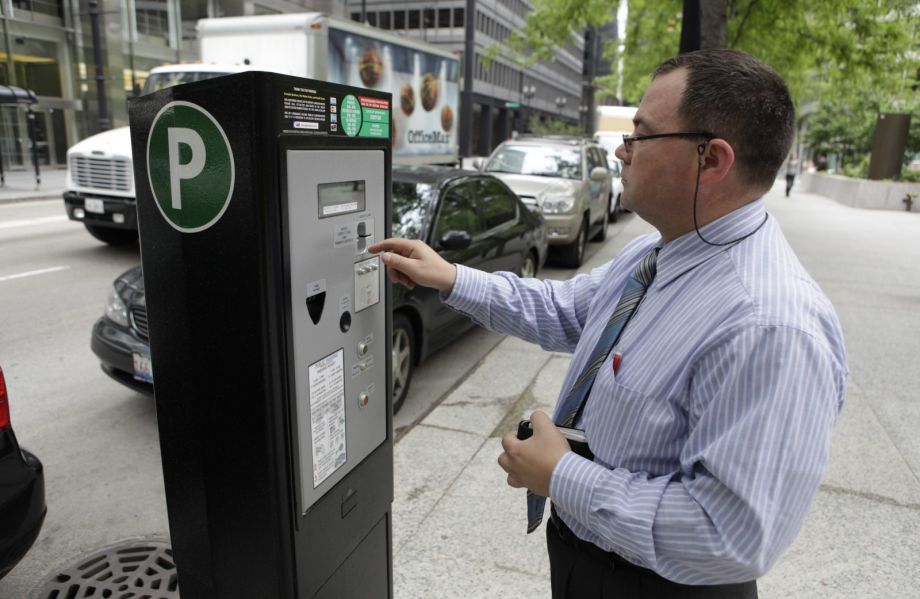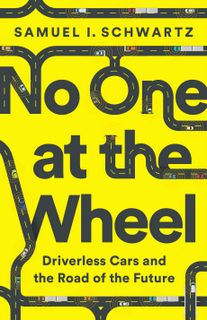Are You A Vanguard? Applications Now Open
A self-driving Uber prototype spotted on the streets of San Francisco in 2016.
Photo by Dllu
This is your first of three free stories this month. Become a free or sustaining member to read unlimited articles, webinars and ebooks.
Become A MemberEDITOR’S NOTE: The following is excerpted from “No One at the Wheel: Driverless Cars and the Road of the Future,” by Samuel I. Schwartz, published by PublicAffairs. In it, the author argues that forward thinking and smart planning will be necessary to grapple with benefits and concerns surrounding the autonomous vehicle (AV) revolution that is taking hold around the world.
When I was growing up, my father had a tiny grocery store in Brooklyn that served our immediate community. Around 1960, something relatively uncommon in Bensonhurst at the time opened about 100 feet away: a supermarket. In our densely populated neighborhood of multifamily houses and apartment buildings, it was the equivalent of Walmart opening in the middle of Main Street in a small town: disruptive, unusual, looming, but still somewhat enticing.
Because of the chain supermarket’s buying power and financial backing, it could undersell my father on some (but not all) products and absorb losing money on these items in order to entice customers into the store to buy other higher-priced products.
Uber and similar ride-hailing services are doing exactly what supermarkets did regarding pricing. These companies are willing to lose money in exchange for market share. They will charge less than a taxi to be competitive and gain riders. (Amazon did the same thing to become a leading e-tailer.) For instance, Uber lost $4.5 billion in 2017; it had lost $2.8 billion in 2016. One analysis suggests that Uber may be covering as little as 41 percent of the cost of its fares. However, Uber stated that in the first three months of 2018, it made $2.45 billion because it sold some assets.
Uber also spends big on lobbying efforts. It employs 250 lobbyists at 49 lobbying firms — a lobbying troop that is larger than Walmart’s. Financing this effort doesn’t come cheap. In Texas, Uber spent upward of $945,000 on lobbying costs in 2015. In 2014, the company spent $684,000 in California, $600,000 in Seattle and $314,000 in Washington, DC; and these figures don’t include the cost of advertising and public relations campaigns. In the first half of 2017, the company spent $1.2 million on lobbying the New York legislature, making it one of the most aggressive lobbyists right as the state was considering legislation to allow ride-hailing companies to operate in upstate New York and on Long Island. The legislation passed.
I believe that the AV industry will follow Uber’s model and engage in pricing wars and aggressive lobbying because of the huge potential profits involved. General Motors president Daniel Ammann says that AVs represent “the biggest business opportunity since the creation of the internet.” Carmakers and tech companies are not going to let that slip through their fingers. The AV industry, as history indicates, will try to undercut every other form of transportation until it controls the sector. Then it will raise prices.

In June 2014, taxi drivers shut down the area around London's Trafalgar Square to protest Uber's unregulated presence in the city. As AV technology takes over, what becomes of these driving jobs? (Photo by David Holt via Flickr)
The many people who work in and around the transportation business — drivers, conductors, machine operators, even insurers and law enforcement — will feel the same way my father did, the way horse breeders felt when the Model T rolled off assembly lines, and how postal workers felt when people started sending e-mail and paying bills online. When an acceleration of autonomous technology takes over jobs and makes competition on price next to impossible, economic battles will ensue. And it won’t be a fair fight. Supermarket chains had some clout in the 1960s, but that was nothing compared to the money and lobbying power of the AV industry in the twenty-first century.
My father’s grocery business was killed by bigger businesses. Malls came along and killed Main Streets. And then internet shopping and home delivery made malls into desolate and often dangerous ghost towns. AVs will have an impact like this on all kinds of transit if we let the AV industry call the shots on regulation, the market and community planning.
No one I know of has done a comprehensive objective study of the economic impacts of AVs, and there is little to no funding available for such research because the AV industry is trying very hard to make it a non-issue. But make no mistake — the economic consequences of AVs will be huge. Some jobs will fall by the wayside and new jobs, still unimagined, will emerge. AV proponents like to say that there could be a $7 trillion — yes, that’s “trillion” — boost to the economy. Change will be rapid.
As Dr. Barry Devlin, an expert in business intelligence, sees it, “The rise of the automobile swept away the horse dung but raised new fears about the livelihoods of stable boys, farriers and coachmen. These fears also turned out to be unfounded; new jobs as valets, mechanics and drivers easily took up the slack.”
The Taxi and Limousine Commission (TLC) of New York says there are 156,000 active taxi and black car drivers in New York City. Will AV technology give them a chance to age out of employment? Or will they be displaced almost overnight? If so, what will they do? What does this technology transition really mean? Can the same people who drive buses become attendants or fleet monitors when autonomy eliminates driving? If transit systems and their unions were forward-looking, they would start retraining people to manage and maintain fleets because people will still be needed for this work even if all transit is automated.
If individual car ownership does indeed decline as AVs are efficiently shared via Uber-style models, fleets will pop up and could grow to mammoth size. They would need people to manage and maintain them. According to Bern Grush’s study on public fleets and how they would be managed in a city of 10 million, total employment for the first 30 billion kilometers (18.6 billion miles) of travel, which is predicted to happen by 2030, would not drop, even if automated trips largely replace labor-intensive taxi and bus trips, because the ratio of human support-to-robo-vehicle would initially be high.
Employment could drop during the second 20 billion kilometers (12.4 billion miles) of travel, but overall or “absolute” employment would increase as owner/drivers were increasingly replaced by the service staffs of fleet operators. “No matter how advanced the technology, these fleets will require human staff far into the future. Certainly, by the time 75 percent robo-vehicle penetration would be achieved in public service vehicles, aggregate job rates for public transportation (including taxi), will be equal to or higher than current average employment rates even as the staff-to-vehicle ratio declines,” says Grush.

An autonomous electric bus in Bad Birnbach, in Germany's Bavaria region. (Photo by Richard Huber)
This net positive job stability is only possible if we do it right. Cost-efficient self-driving cars that deliver point-to-point transportation, whether owned or hailed, could shift commuter preferences away from public transit, and such a shift would affect government revenues. Moreover, reducing monies spent on public transit and underfunding badly maintained systems would have a negative impact on transport for those not lucky enough to have access to personal vehicles or rides, devastating both people who are already lower on the social and economic equity scales and the cities where they live.
If we get autonomous transit right and communities do not orient themselves around single-rider modes of transport (whether owned cars or hailed rides), strong networks of well-funded, affordable automated buses and train services could be developed and commuters and communities would win. Intelligent transportation systems (ITS) can meet these challenges as they incorporate connected and autonomous vehicles, alternative fuels, management of AV fleets and analysis of traffic patterns, as well as local zoning and planning policies that support transit-oriented development. If communities can create a robust network of mobility options based on ride-sharing, car ownership could be reduced and use of public transit increased. Even if automated, these systems can’t be implemented without people — perhaps not drivers, but transit managers, onboard attendants, maintenance crews and back-office workers.
If vehicles become more fuel-efficient, they will deliver less gas tax revenue. How will state governments replace that revenue, as well as the revenue from parking fines and moving violations? Governments may naturally end up paying for infrastructure and public transit (which today benefit from gas taxes and, to an extent, fine revenue) by instead instituting fees based on the use of roads by distance and/or time, congestion pricing and more substantial fuel taxes. To assess how vulnerable cities’ budgets could be, Governing magazine conducted the first national analysis of the impact of AVs on city revenues. For the twenty-five largest US cities, this analysis looked at parking collections and fines, traffic citations, traffic camera fines, gas taxes as well as vehicle registration, licensing and other fees. These twenty-five cities collectively netted nearly $5 billion in auto-related revenues in fiscal 2016, or about $129 per capita. While some cities will see hardly any effect on their budgets, the fiscal consequences of AVs for others could be big. Cities and towns could face unprecedented losses in revenue from parking tickets alone.
New York City collected a record $1.9 billion in fees and fines during its 2015 fiscal year, many from parking and driving violations, but also from littering and noise pollution (which is often triggered by blasting car and truck horns). The 2015 total was an increase of 5.5 percent over the $1.8 billion collected in 2014, and a 13 percent increase from 2012, when the city collected $1.7 billion. The largest jump in fines and fees came from violations of red light, bus lane and speed cameras near schools. Vehicles programmed to obey traffic laws won’t need nearly as much policing, which also means fewer traffic police will be needed, fewer traffic tickets will be issued and less revenue will flow into municipalities.

In this 2009 file photo, Sicilia Giovanni feeds one of Chicago's parking meters. Chicago is one of the municipalities that stands to lose significant revenue from parking and traffic violations once AV technology becomes widespread on city streets. (AP Photo/Charles Rex Arbogast, File)
The analysis found that the cities most likely to suffer the steepest revenue losses per capita include San Francisco ($512), Washington, DC ($502) and Chicago ($248). “Totals were much larger in cities assessing special taxes on parking operators, deploying traffic cameras or those receiving substantial shared revenues from states in the form of gas taxes or vehicle registration fees,” the report says.
Other countries around the world also depend on ticket revenue. Florence, Italy, for example, takes in more than €50 million each year from traffic tickets, a good percentage of them issued to visitors in European rental cars, according to Gemut, a European travel agency. Technology has allowed municipalities to catch more violators and most tickets in Europe are issued electronically. Cameras, not cops, catch drivers speeding, talking on a cell phone, not wearing a seat belt, driving in a restricted zone, or following too closely.
Autonomous technology would make VMT fees much easier to administer, says Paul Lewis of the Eno Center for Transportation, a foundation dedicated to improving transportation. Eno proposes a national baseline per-mile fee on autonomous vehicles that would vary rates depending on the type of vehicle, the number of passengers and other factors. Oregon operates a voluntary VMT program that charges participants 1.5 cents per mile and gives them a tax credit for fuel taxes paid. The state’s Department of Transportation is considering testing new technology that would enable localities to assess their own fees on top of the state rate. That would probably require federal approval. I have long advocated for congestion pricing in dense cities that includes not only a vehicle-miles-traveled charge but a vehicle-hours-traveled (VHT) charge. This is an important distinction since slower speeds in cities make the number of miles traveled relatively low.
Large cities like New York could recoup lost ticketing revenue by taxing or licensing autonomous vehicle services. Seattle collected $2.4 million in the 2016 fiscal year through fees paid by car-sharing services. New York State is estimating over $400 million to be collected in 2019 when a law charging Uber, Lyft, taxis and other car services up to $2.75 per trip in the business district goes into effect. But this kind of revenue source can’t overcome sizable revenue reductions elsewhere.
Smaller cities and towns, as well as suburban towns and rural villages that raise funds via ticketing, could experience a renaissance. If individual vehicle ownership is reduced and parking spaces and garages are repurposed as more aesthetically pleasing mixed-use spaces, downtowns could become more active. Lost ticketing monies could thus be recouped through the reuse of parking and driving land for ongoing public events like farmers’ markets, art exhibitions, concerts and other old-fashioned events like those that used to bring people into the town square.
By allowing a greater variety of development, mixing in affordable residential ownership with retail, hospitality and professional businesses, communities of every size can draw people into downtowns, where they’ll spend more money the longer they stay in the area. Real estate tax revenue is likely to rise too. Machines can’t run all of these businesses and as many futurists predict, a rejection of technology among current and future generations may increase the demand for vibrant places that promote human-to-human contact. In this regard, smaller towns and cities that engage their populations could win economically without writing a single speeding or parking ticket.
Forward-looking entrepreneurs who can successfully identify changing market dynamics and create new businesses may create new jobs. But what about economic justice? What about those who suffer from employment inequity already? Will AVs save them or hurt them further? The new technology could provide some advantages to the most vulnerable and disadvantaged by supporting cheaper and more convenient ways to get around if public and private transit work together to serve communities that are ill-served by current transit options. Robo-buses and shared robo-taxis could increase the mobility of disadvantaged, disabled and elderly people. A US Bureau of Transportation Statistics survey found that almost 15 million people, six million of whom are disabled, have difficulty getting the transportation they need. Moreover, the infrequency and inefficiency of public transit are often cited as barriers to people looking for work and who do not have access to a personal vehicle.
My father’s grocery business was killed by the supermarket. Malls came along and killed Main Streets. And internet shopping made malls into ghost towns. AVs will have a similar impact on all forms of transit if we let the AV industry call the shots on regulation, the market and community planning.
In 2017, CBS reported on a young man, Justin Korva, who walked three miles to and from his job at a restaurant in Rockwall, Texas. He was picked up by a friendly stranger, who posted about the encounter on social media and in short order those who saw the post raised enough money for Korva to buy a used car — which he, of course, would have to insure, fill with gas and maintain to keep in working order. The kind stranger, Andy Mitchell, also bought him a $500 car card and one year’s worth of insurance. It can certainly get punishingly hot in Texas, and walking to a job where you stand all day and then walking home, even three miles, is not easy. However, just imagine if Korva had access to autonomous transit — a public or private bus or van that could take him where he needed to go for work at far less cost per year than a car. Why is the car our default solution to transit issues? The feel-good story did not delve into this, but according to autotrader.com, it costs at least a few thousand dollars a year to keep a used car running and insured at minimum standards.
In order for cities and downtowns of any shape or size to increase commerce, they have to be friendly not just toward commuters but toward visitors and residents. Barbara Gray, the general manager of transportation services for Toronto (and formerly of the Seattle Department of Transportation), says that businesses are always prickly about modifying curb space for anything other than parking. “However, we have seen clearly in Seattle and in Montreal that people prefer to travel to get all of their basic needs filled via walking, biking and public transit if it is safe, reliable and convenient and if driving is not convenient or reliable.”
This preference for travel is why it is so important for planning and public policy to be pro-pedestrian and cyclist and less congenial toward AVs. Although Gray says that businesses can be reluctant to make curb changes that do not address parking, they shouldn’t be. People on foot and on bikes can actually spend more than people in cars in downtown areas. The conventional wisdom is that “kids on bikes” have no money but “people in cars” do. According to a study done by the Oregon Transportation Research and Education Consortium, drivers still make up a plurality of customers at businesses. It’s not surprising that drivers, having greater trunk capacity, would far outspend people who travel to grocery stores by foot, bike, or transit.
But for all of the other business types, the study found, including restaurants, bakeries, boutiques, specialty shops and wine stores, cyclists and pedestrians actually out-consumed drivers over the course of a month. Although cyclists and pedestrians spent less per visit, both made more frequent trips and that added up to more engagement and more spending. Engagement also links to customer loyalty. “Such frequent visits are part of the walkable culture. Compare European communities — where it’s common to hit the bakery, butcher and fish market on the way home from work — to US communities where the weekly drive to Walmart’s supermarket requires an hour of dedicated planning,” said CityLab in its report on the findings.

One major economic advantage of AVs may be the side effect of reductions in traffic crashes and related health care costs. Indeed, the insurance industry may have to reinvent itself: according to a study from the nonprofit Eno Center for Transportation, if just 10 percent of cars and trucks in the United States were self-driving, the number of traffic deaths could be cut by 1,000 per year. There could also be a savings of just under $38 billion a year. If 90 percent of vehicles in the United States were self-driving, the study predicts, 4.2 million crashes could be avoided, with 21,700 lives saved along with about $450 billion in related costs annually. Worldwide over a million lives could be saved. With these stats, no wonder there is such a strong push for AVs. But we need to look carefully at safety and other health-related claims before turning over our streets to AVs en masse.
Excerpted from “No One at the Wheel: Driverless Cars and the Road of the Future,” by Sam Schwartz. Copyright © 2018. Available from PublicAffairs, an imprint of Perseus Books, LLC, a subsidiary of Hachette Book Group, Inc.
_2015_200_200_80_c1.jpg)
Sam Schwartz, a.k.a. “Gridlock Sam,” is one of the leading transportation experts in the United States today. He is the author of “No One at the Wheel: Driverless Cars and the Road of the Future“ and “Street Smart.” He served as New York City’s traffic commissioner and the New York City Department of Transportation’s chief engineer. Schwartz currently runs Sam Schwartz Engineering and is a columnist at the New York Daily News.

20th Anniversary Solutions of the Year magazine